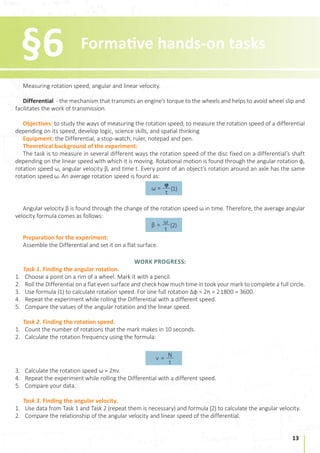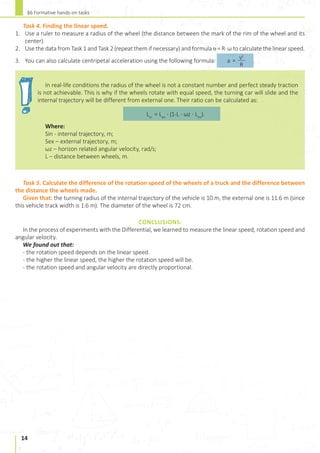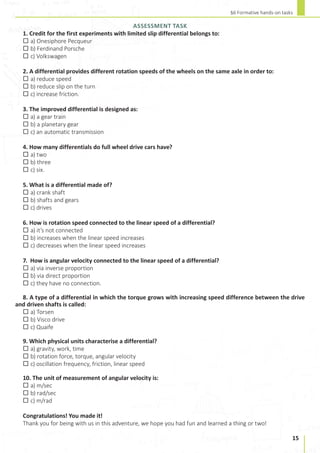The document provides information about differentials and how they work:
1) A differential is a gear arrangement that allows the left and right wheels of a vehicle to rotate at different speeds while turning, which improves stability and prevents slipping. It transmits torque from the engine and divides it between the two wheels.
2) The first differential was invented in 1825 by a French engineer to address the problem of wheel slip when turning, but it was improved by Ferdinand Porsche in the early 20th century.
3) A differential uses planetary gears to distribute torque from the engine to the left and right half-axles. This allows the wheels to rotate at different speeds when turning or driving on uneven surfaces

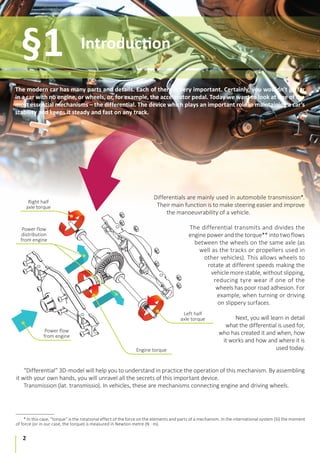



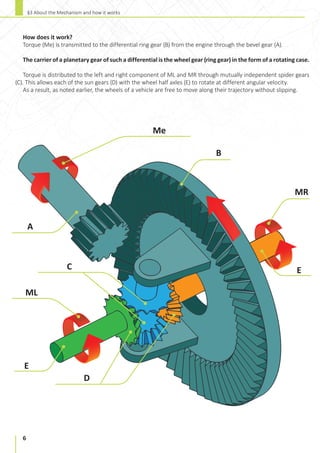
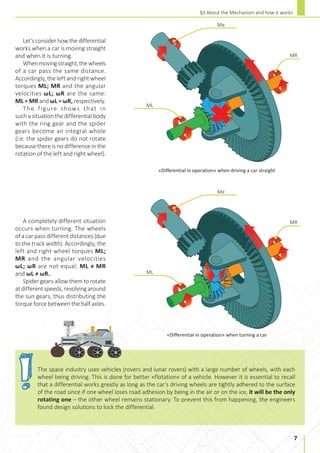
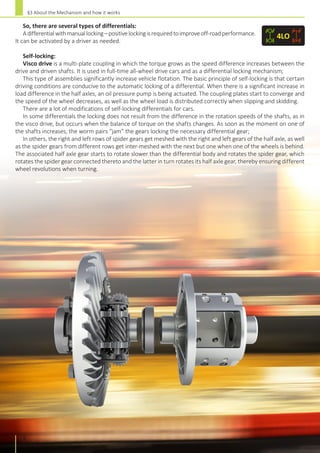

![10
A differential is a mechanical device that transfers torque from a source to two independent drives in the way
that the rotation speed of each of those can be different.
A differential has the following properties: the Rotation power (N), torque (M), and angular velocity (ω).
Power is a scalar value that in most cases equals the rate of conversion, transmission or consumption of the
system’s energy. It is also described as a relation of the work in the period of time to that period of time.
N = A/t
In the International System of Units (SI) the base unit of the power is watt (W), named after James Watt, an
18th-century Scottish inventor.
Power is found by the formula:
N = F∙v∙cosα
In the rotation motion:
N = M ∙ ω,
Where:
М – is torque,
ω – angular velocity.
Torque can also be called “a rotating power”, N·m in the SI unit. Torque is sometimes called “moment of couple of
forces”. This term is initially found in Archimedes’ works. If the direction of the force applied to a lever is perpendicular
to it, the moment of power is found as a the amount of that power multiplied by the distance to the center of line
of rotation of the lever. For an engine it’s the rotation force of the crank shaft.
For example, the force of 3 N applied to a lever at a distance of 2 meters from the center of its line of rotation
will create the same torque as the force of 1 N applied to the lever at the distance of 3 meters from the center of
its line of rotation. The moment on point is describes as a vector multiplication:
М = [r × F]
Where:
F is a force applied to a point,
r is a vector radius of a point (if the center of rotation is at the at the origin of the coordinates).
Physics and Mechanics
explained in “Differential”
STEM-model
§4](https://image.slidesharecdn.com/differential-pocket-study-guide-ugears-stem-lab-de-210702182503/85/Differential-pocket-study-guide-ugears-stem-lab-de-10-320.jpg)
![11
§4 Physics and Mechanics explained in “Differential” STEM-model
Angular velocity refers to how fast the angular position (φ) or orientation of an object changes with time. It is
represented by the symbol ω and the formula:
φ
t
=
ω
Per one revolution Δφ = 2π.
Angular velocity is related to the period of rotation and number of revolutions per period of time. It is found as:
2π
T
=
ω и ω = 2πν
As a SI unit, angular velocity is: [ω]=рад/с.
The real radius of a turn is not a constant number and perfect steady traction is not achievable. If the wheels
rotate with the same speed, the turning car will slide and the internal trajectory will be different from external
one. This difference is found as:
Lin = Lex
∙ (1-L ∙ ωz ∙ Lex
).м
Where:
Sin - internal trajectory, m;
Sex – external trajectory, m;
ωz – horizon related angular velocity, rad/s;
L – distance between wheels, m.](https://image.slidesharecdn.com/differential-pocket-study-guide-ugears-stem-lab-de-210702182503/85/Differential-pocket-study-guide-ugears-stem-lab-de-11-320.jpg)

